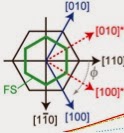A previous post considered the large orbital magnetoresistance observed in PdCo2 and reported in a recent PRL. The magnetoresistance depends significantly on the direction of the intralayer field. Below I show the results of a very simple model calculation, that explain several key features of the observations. The essential physics of the model was mentioned in the PRL, but the authors reported a full numerical calculation of the magnetoresistance. The outer hexagon below is the first Brillouin zone within the layers. The inner green hexagon is the Fermi surface.
The observations explained by the model include:
- the magnetoresistance for intralayer fields can be orders of magnitude larger than fields perpendicular to the layers,
- for fields in the [110] direction the magnetoresistance saturates at high fields [but, it looks like the experimental value is larger than the predicted value of 200%] and the resistance will decrease monotonically with decreasing temperature, like the zero-field resistance,
- for fields in the [1-10] direction the magnetoresistance increase monotonically with field and the resistance will decrease non-monotonically with temperature, as highlighted in the previous post,
- for low fields the magnetoresistance is isotropic with respect to intralayer field direction.
Right click on the notes to see a larger version. The formula for interlayer conductivity comes from a simple solution of the Boltzmann equation. It can be found here and here.





No comments:
Post a Comment